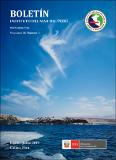Por favor, use este identificador para citar o enlazar este ítem:
https://hdl.handle.net/20.500.12958/3364Registro completo de metadatos
| Campo DC | Valor | Lengua/Idioma |
|---|---|---|
| dc.contributor.author | Sánchez, Sonia | - |
| dc.contributor.author | Villanueva Merino, Patricia | - |
| dc.contributor.editor | Instituto del Mar del Perú | - |
| dc.date.accessioned | 2019-09-10T20:03:34Z | - |
| dc.date.available | 2019-09-10T20:03:34Z | - |
| dc.date.issued | 2019 | - |
| dc.identifier.citation | Bol Inst Mar Perú. 34(1) 2019: p.25-34 | es_ES |
| dc.identifier.issn | 03787702 | - |
| dc.identifier.uri | https://hdl.handle.net/20.500.12958/3364 | - |
| dc.description.abstract | El crucero abarcó del Callao a Paita, hasta 200 mn. Se recolectaron 21 muestras, utilizando una red de fitoplancton con 75 micras de abertura. Los volúmenes de plancton alcanzaron un promedio de 1,63 mL/m3 con 62% de los valores menores a 1,0 mL/m3. Hubo mayor representatividad del zooplancton en la parte oceánica, el fitoplancton estuvo dentro de las 30 mn. Chimbote fue el lugar de mayor biomasa planctónica. Condiciones del evento La Niña, al parecer influyó en la distribución de los organismos indicadores, sin embargo la presencia de Ceratium breve, indicador de Aguas Ecuatoriales Superficiales (AES), a 150 mn de Chimbote y Callao, indicó rezagos de incursiones anteriores. El ACP mostró que la temperatura fue el parámetro de mayor aporte del eje 1 y la latitud del eje 2. Este análisis definió grupos que coincidieron con la presencia de un solo indicador de masa de agua. | es_ES |
| dc.description.abstract | ABSTRACT: The cruise covered the area from Callao to Paita, up to 200 mn. A total of 21 samples were collected using phytoplankton net (75 μm). Zooplankton was more representative in the oceanic part while phytoplankton was within 30 nm. Chimbote was the place whose plankton biomass was the highest. La Niña event conditions seem to have influenced the distribution of indicator organisms, although the presence of Ceratium breve, an indicator of Surface Equatorial Waters (SEW), at 150 nm off Chimbote and Callao, showed delays from previous incursions. PCA showed that temperature was the parameter of greatest contribution of axis 1 and latitude was for axis 2. This analysis defined groups that coincided with the presence of a single water mass indicator. | - |
| dc.language.iso | spa | es_ES |
| dc.publisher | Instituto del Mar del Perú | es_ES |
| dc.relation.ispartofseries | Boletín IMARPE;34(1), 2019 | - |
| dc.rights | info:eu-repo/semantics/openAccess | es_ES |
| dc.rights.uri | https://creativecommons.org/licenses/by/4.0/ | es_ES |
| dc.source | Instituto del Mar del Perú - IMARPE | es_ES |
| dc.source.uri | Repositorio Digital IMARPE | es_ES |
| dc.subject | Fitoplancton | es_ES |
| dc.subject | Organismos indicadores | es_ES |
| dc.subject | Ambiente marino | es_ES |
| dc.subject | Otoño 2007 | es_ES |
| dc.title | Variabilidad de la comunidad fitoplanctónica en otoño 2007. Crucero 0705-06 | es_ES |
| dc.title.alternative | Variability of the phytoplankton community in autumn 2007. Cruise 0705-06 | es_ES |
| dc.type | info:eu-repo/semantics/article | es_ES |
| Aparece en las colecciones: | Boletín 34(1), 2019 | |
Ficheros en este ítem:
| Fichero | Descripción | Tamaño | Formato | |
|---|---|---|---|---|
| Boletin 34(1)-3.pdf | 1,18 MB | Adobe PDF |  Visualizar/Abrir |
Este ítem está sujeto a una licencia Creative Commons Licencia Creative Commons

